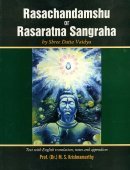Shuktika, Śuktikā: 10 definitions
Introduction:
Shuktika means something in Hinduism, Sanskrit, Marathi. If you want to know the exact meaning, history, etymology or English translation of this term then check out the descriptions on this page. Add your comment or reference to a book if you want to contribute to this summary article.
The Sanskrit term Śuktikā can be transliterated into English as Suktika or Shuktika, using the IAST transliteration scheme (?).
In Hinduism
Shaktism (Shakta philosophy)
Source: Kamakoti Mandali: The Yoginis of Narasimha VyuhaŚuktikā (शुक्तिका) is the name of a Mātṛkā-Śakti created by Mahārudra in order to control the plague of demons created by Andhakāsura.—Accordingly, Andhaka-Asura tried to kidnap Umā (Devī Pārvatī), and was fiercely attacked by Mahārudra who shot arrows at him from his mahāpināka. when the arrows pierced the body of Andhakāsura, drops of blood fell to earth and from those drops, thousands of Andhakas arose. To control this plague of demons, Mahārudra created Mātṛkā-Śaktis [viz., Śuktikā] and ordered them to drink the blood of the demons and drain them dry.
Source: Kamakoti Mandali: Nrisimha matrika-mandalaŚuktikā (शुक्तिका) refers to one of the various Mātṛkā-Śaktis created by Rudra in order to destroy the clones that spawned from Andhaka’s body.—Accordingly, [...] Andhakāsura attempted to abduct Girājanandinī (Pārvatī) and thus ensued a fierce battle between Andhakāsura and the great Rudra, the Lord of Umā. Like raktabīja, every drop of blood that fell from the body of Andhaka created another Asura like him and in no time, the entire world was filled with Andhakas. To destroy the growing number of Andhakas, Rudra created innumerable Mātṛkā-Śaktis [viz., Śuktikā]. These Śaktis of immense power at once began to drink every drop of blood that flowed from the body of Andhaka, but they could still not effectively contain the emergence of more and more demons.

Shakta (शाक्त, śākta) or Shaktism (śāktism) represents a tradition of Hinduism where the Goddess (Devi) is revered and worshipped. Shakta literature includes a range of scriptures, including various Agamas and Tantras, although its roots may be traced back to the Vedas.
Ayurveda (science of life)
Toxicology (Study and Treatment of poison)
Source: Shodhganga: Kasyapa Samhita—Text on Visha ChikitsaŚuktikā (शुक्तिका) referrs to “pearls”, and is used in the treatment of rat-poison such as those caused by the Ugra-rats, according to the Kāśyapa Saṃhitā: an ancient Sanskrit text from the Pāñcarātra tradition dealing with both Tantra and Viṣacikitsā—an important topic from Āyurveda which deals with the study of Toxicology (Viṣavidyā or Sarpavidyā).—Accordingly, one of the treatments is mentioned as follows: “Must take a tablet or Gulikā made from pearl (śuktikā) and silver. Fruit and powder of the roots of Śvetaśarapuṅkha and Kaṇṭhapuṅkha garnished with the bark of Pūtikā. Victim must be given a drink of gruel made of barley, Puṅkha and Ākhukarṇikā. The same can be used as ointment as well. Fumigation with jaggery and hair of mongoose prescribed. Curd must be taken”.

Āyurveda (आयुर्वेद, ayurveda) is a branch of Indian science dealing with medicine, herbalism, taxology, anatomy, surgery, alchemy and related topics. Traditional practice of Āyurveda in ancient India dates back to at least the first millenium BC. Literature is commonly written in Sanskrit using various poetic metres.
Languages of India and abroad
Marathi-English dictionary
Source: DDSA: The Aryabhusan school dictionary, Marathi-Englishśuktikā (शुक्तिका).—f A pearl-oyster.
Marathi is an Indo-European language having over 70 million native speakers people in (predominantly) Maharashtra India. Marathi, like many other Indo-Aryan languages, evolved from early forms of Prakrit, which itself is a subset of Sanskrit, one of the most ancient languages of the world.
Sanskrit dictionary
Source: DDSA: The practical Sanskrit-English dictionaryŚuktikā (शुक्तिका).—A pearl-oyster.
Source: Cologne Digital Sanskrit Dictionaries: Shabda-Sagara Sanskrit-English DictionaryŚuktikā (शुक्तिका).—f.
(-kā) 1. A pearl-oyster. 2. A sort of dock or sorrel. E. śukti as above, or śukta sour, kan added, fem. form.
Source: Cologne Digital Sanskrit Dictionaries: Cappeller Sanskrit-English DictionaryŚuktikā (शुक्तिका).—[feminine] pearl-oyster or oyster-shell.
Source: Cologne Digital Sanskrit Dictionaries: Monier-Williams Sanskrit-English Dictionary1) Śuktika (शुक्तिक):—[from śukta] m. a [particular] disease of the cornea, [Śārṅgadhara-saṃhitā]
2) Śuktikā (शुक्तिका):—[from śuktika > śukta] f. idem, [Suśruta]
3) [v.s. ...] mother of pearl, [Śaṃkarācārya; Sarvadarśana-saṃgraha]
4) [v.s. ...] Rumex Vesicarius, [cf. Lexicographers, esp. such as amarasiṃha, halāyudha, hemacandra, etc.]
5) Sūktika (सूक्तिक):—[from sūkta] m. (in music) a kind of cymbal, [Saṃgīta-sārasaṃgraha]
Source: Cologne Digital Sanskrit Dictionaries: Yates Sanskrit-English DictionaryŚuktikā (शुक्तिका):—(kā) 1. f. A pearl oyster; sorrel.
[Sanskrit to German]
Sanskrit, also spelled संस्कृतम् (saṃskṛtam), is an ancient language of India commonly seen as the grandmother of the Indo-European language family (even English!). Closely allied with Prakrit and Pali, Sanskrit is more exhaustive in both grammar and terms and has the most extensive collection of literature in the world, greatly surpassing its sister-languages Greek and Latin.
See also (Relevant definitions)
Starts with: Shuktika-rajataniyayam, Shuktikadi, Shuktikarna, Shuktikavati.
Ends with: Irvalushuktika, Irvarushuktika, Irvvarushuktika, Kshudrashuktika, Shankhashuktika, Svarnashuktika, Toyashuktika.
Full-text: Toyashuktika, Irvarushuktika, Shankhashuktika, Shukti, Shuktika-rajataniyayam, Kshudrashuktika, Shaukteya, Svarnashuktika, Irvvarushuktika.
Relevant text
Search found 7 books and stories containing Shuktika, Śuktikā, Suktika, Śuktika, Sūktika; (plurals include: Shuktikas, Śuktikās, Suktikas, Śuktikas, Sūktikas). You can also click to the full overview containing English textual excerpts. Below are direct links for the most relevant articles:
Sushruta Samhita, Volume 6: Uttara-tantra (by Kaviraj Kunja Lal Bhishagratna)
Chapter IV - Pathology of the diseases of the sclerotic coat < [Canto I - Shalakya-tantra (ears, eyes, nose, mouth and throat)]
Chapter VIII - Classification and treatment of ocular affections < [Canto I - Shalakya-tantra (ears, eyes, nose, mouth and throat)]
Vasistha Dharmasutra (by Georg Bühler)
A History of Indian Philosophy Volume 4 (by Surendranath Dasgupta)
Part 4 - Illusion and Doubt < [Chapter XXVII - A General Review of the Philosophy of Madhva]
The Garuda Purana (by Manmatha Nath Dutt)
Chapter CLXXI - The Nidanam of diseases of the eyes < [Dhanvantari Samhita]
Anumana in Indian Philosophy (by Sangita Chakravarty)
Classification of knowledge (2): Invalid Knowledge < [Chapter 1 - Introduction]
Amarakoshodghatana of Kshirasvamin (study) (by A. Yamuna Devi)
Related products
